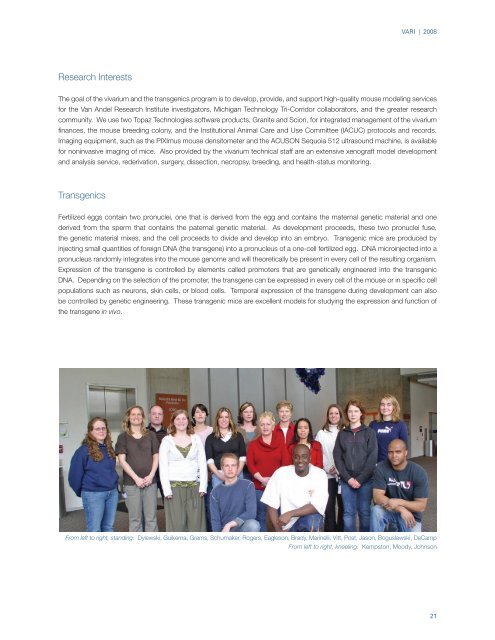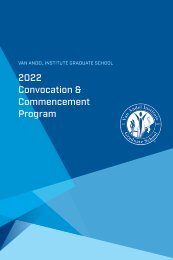2008 Scientific Report
You also want an ePaper? Increase the reach of your titles
YUMPU automatically turns print PDFs into web optimized ePapers that Google loves.
VARI | <strong>2008</strong><br />
Research Interests<br />
The goal of the vivarium and the transgenics program is to develop, provide, and support high-quality mouse modeling services<br />
for the Van Andel Research Institute investigators, Michigan Technology Tri-Corridor collaborators, and the greater research<br />
community. We use two Topaz Technologies software products, Granite and Scion, for integrated management of the vivarium<br />
finances, the mouse breeding colony, and the Institutional Animal Care and Use Committee (IACUC) protocols and records.<br />
Imaging equipment, such as the PIXImus mouse densitometer and the ACUSON Sequoia 512 ultrasound machine, is available<br />
for noninvasive imaging of mice. Also provided by the vivarium technical staff are an extensive xenograft model development<br />
and analysis service, rederivation, surgery, dissection, necropsy, breeding, and health-status monitoring.<br />
Transgenics<br />
Fertilized eggs contain two pronuclei, one that is derived from the egg and contains the maternal genetic material and one<br />
derived from the sperm that contains the paternal genetic material. As development proceeds, these two pronuclei fuse,<br />
the genetic material mixes, and the cell proceeds to divide and develop into an embryo. Transgenic mice are produced by<br />
injecting small quantities of foreign DNA (the transgene) into a pronucleus of a one-cell fertilized egg. DNA microinjected into a<br />
pronucleus randomly integrates into the mouse genome and will theoretically be present in every cell of the resulting organism.<br />
Expression of the transgene is controlled by elements called promoters that are genetically engineered into the transgenic<br />
DNA. Depending on the selection of the promoter, the transgene can be expressed in every cell of the mouse or in specific cell<br />
populations such as neurons, skin cells, or blood cells. Temporal expression of the transgene during development can also<br />
be controlled by genetic engineering. These transgenic mice are excellent models for studying the expression and function of<br />
the transgene in vivo.<br />
From left to right, standing: Dylewski, Guikema, Grams, Schumaker, Rogers, Eagleson, Brady, Marinelli, Vitt, Post, Jason, Boguslawski, DeCamp<br />
From left to right, kneeling: Kempston, Moody, Johnson<br />
21

















